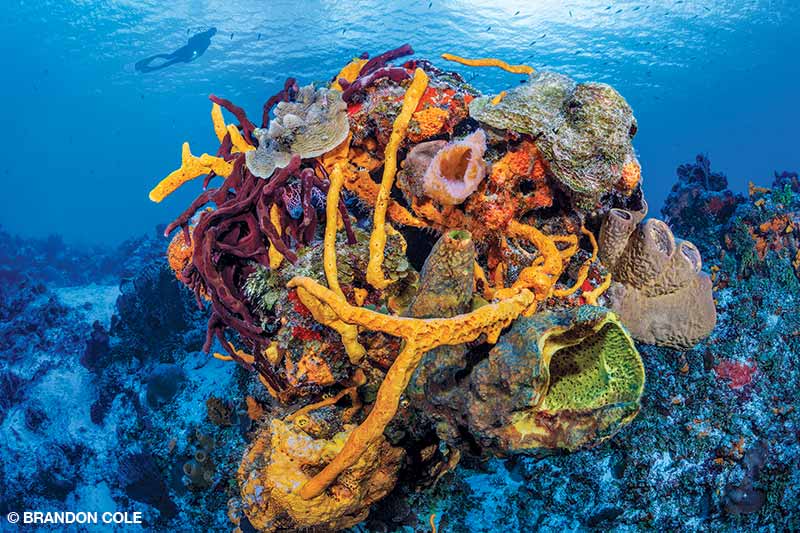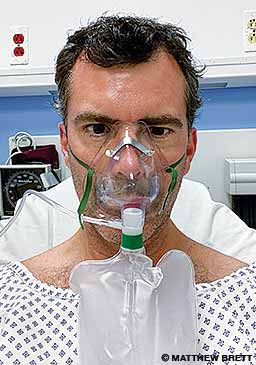I began diving in 2013 at age 44. Diving had always intrigued me, and once I got started, I was hooked. There’s nothing else like it. Since that time, diving has inspired my travel, taking me to Palau, Thailand, Socorro, Bonaire and beyond.
For a Midwesterner like myself, however, Cozumel is among the best of dive destinations. It’s close, it’s affordable, and the diving is spectacular.
This past Christmas I visited Cozumel for a week of drift diving. I’ve been to the island several times and always come away with a renewed sense of appreciation for its beauty and awe for the eagle rays, sea turtles and other marine life that call the waters home.
Our first morning dive was a checkout dive to determine everyone’s skill level before the week of diving. It was easy, with a maximum depth of 75 feet (23 meters) for 50 minutes. The current was slight, and the visibility was spectacular — an ideal first dive. It closed with a nice, slow ascent and a three-minute safety stop.

When we returned to the boat, I removed my wetsuit and stashed my gear. I felt a sudden tingling in my right foot followed by a dull ache in my knee, as if I had just finished a long run. I assumed the worst, thinking I had decompression sickness (DCS). When I reviewed the dive in my mind, however, that seemed impossible. I’ve had similar or more challenging dive profiles hundreds of times. Furthermore, I was diving 32 percent nitrox. Since most of the divers in our group were on air, we all dived an air profile, and I use a conservative dive computer.
Given all these factors, I dismissed my initial concerns; after an hour surface interval, I made the second dive without further thought. The following day I did two morning dives with similar depth profiles. The tingling in my foot was gone, but my knee continued to be bothersome. It simply felt off, but not in a way that was typical of muscle or joint soreness. At this point I was beginning to appreciate the old saying that the first symptom of DCS is denial.
When I returned to my hotel, I called DAN® with what I assumed was an overabundance of caution. I spoke with a medic, who patiently noted my dive profiles and symptoms and then calmly but firmly said, “You need to get to a hospital.”
Those are not words anyone wants to hear, especially when on vacation.
By the time I arrived at Costamed, the recommended health care provider in Cozumel, DAN had already contacted them, and Dr. Jorge Darío Gómez Castillo was waiting for me. My first question to him was, “Are you a diver?” He smiled, nodded and performed some balance and reflex tests. He told me to close my eyes and hold my hands in front of me with palms up. I was sure I could do that, but I almost fell over, and he had to catch me. I finally realized how bad my condition was.
Sure enough, I had a mild case of DCS. They immediately put me on IV fluids and 100 percent oxygen and recommended a U.S. Navy Treatment Table 6 recompression therapy in the hyperbaric chamber. It was all painless, just a bit boring and uncomfortable. I passed the time watching John Wick movies with the chamber tender, although my view of the screen was only through the chamber’s porthole. My knee pain lessened throughout the treatment.

I stayed at Costamed overnight and had a post-treatment evaluation the next morning. My knee pain was gone entirely. They discharged me with a recommendation to not dive until I had a follow-up review with a physician and received clearance to return to diving. I spent the rest of the week above the water, disappointed about not being able to dive but grateful I was OK.
My case of DCS was mild, but it could have easily been much worse. When I recall my dive and actions leading up to it, I draw a blank regarding what triggered the incident. There was no violation on my dive profile and no exacerbating circumstances regarding dive conditions. The only possible contributing factor I could come up with was potentially being dehydrated. I traveled from Chicago to Cozumel the day before diving and likely did not drink as much water as I typically would.
The reality is that not identifying a cause should not change your response to experiencing symptoms. There’s a tendency to not talk about getting DCS — the prevailing wisdom being that the diver must have been at fault and made a mistake. Diver error is not always the case, and this shaming is counterproductive to divers seeking treatment when they think they may have DCS. Dr. Castillo said that 80 percent of the patients he treats for DCS were diving within safe profiles.
I should not have waited until the second day to get treatment simply because I thought it was impossible for me to have DCS.
I have two pieces of advice for my fellow divers. First, if you think you have DCS, there’s a good chance you are correct. Just because you followed every rule and dived conservatively doesn’t mean it can’t happen to you. Follow your gut instinct and call DAN. Don’t try to rationalize your way out of making the smart choice for your health. A minor case of DCS left untreated can become highly problematic.
Second, make sure your DAN membership and dive accident insurance are current. I can’t say enough about how quickly and thoroughly DAN handled my case, helping me navigate health care in a country where the logistics would have been daunting. Not having to be concerned about paying out of pocket for medical care was a huge load off my mind. I had enough things to deal with without adding that into the mix.
My 2021 goal is to get my divemaster certification, and when I do, it will be in Cozumel. You can be sure that my DAN membership and dive accident insurance coverage will be current.
Many thanks to DAN, Dr. Castillo and Costamed of Cozumel. Safe diving to all.
© Alert Diver — Q2 2021